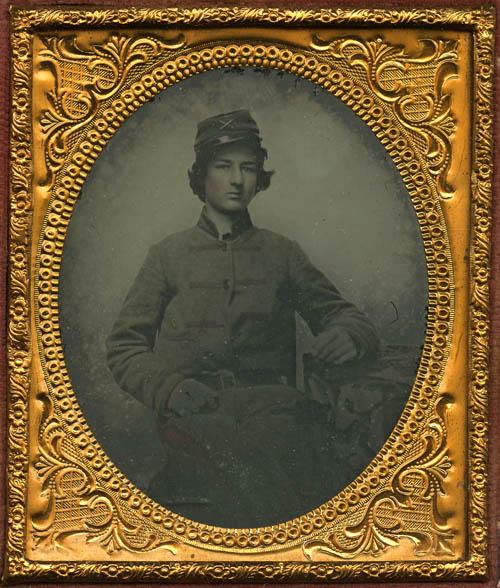William E. Woodruff, Jr. Papers

Image courtesy of Wilson’s Creek National Battlefield; WICR 30058
William E. Woodruff , Jr. was born into one of the most prominent families in Arkansas on June 8, 1832. His father, William Woodruff, Sr., was the editor of the state’s best known newspaper, Arkansas Gazette.1 Woodruff Jr. graduated from the Western Military Institute in 1852 and then studied law. He settled in Little Rock where he opened a law office in 1859. Shortly after Woodruff’s arrival in Little Rock, plans were made to organize another company for service in the state militia. Since Pulaski County had already fulfilled its allotment of infantry and cavalry units, an artillery company was organized with Woodruff as its captain. It was named the “Totten Artillery,” in honor of local physician Dr. William Totten. The name was even more appropriate when Dr. Totten’s son, Captain James F. Totten arrived with sixty-five men from the Second United States Artillery in November 1860. Woodruff recalled that Captain Totten assuming command of the arsenal “was very easy and agreeable to society.”2
Woodruff later wrote of the standoff, “wise counsels prevailed and diplomacy of citizens accomplished peacefully what if force had been used, might have resulted in bloodshed within half a miles of the business center of the city.”5 Woodruff admitted many in Little Rock had hoped that Totten would join the Southern case. When they realized it was not to be, many citizens cheerfully escorted the captain and his detachment to the steamer that carried them to St. Louis, and ultimately a confrontation with their new artillery company.6
With war now imminent, Woodruff worked to make sure his command was ready for the coming struggle. On February 14, 1861, he wrote to Colonel C. Peyton of the 13th Arkansas State Militia asking that equipment be requisitioned from the governor. Woodruff needed equipment for fifty men, including, “50 minnie Rifles, 1 Battery consisting of Three 6 – pounder cannon and one 12 pounder Howitzer &c. &c. Side arms for 50 officers and men . . . . It is desirable that the rifles should be issued at once, in order that said Company may be speedily acquainted with their arm. – The Artillery will not be required before the return of Commpanes Churchill and Durley.”
Once in St. Louis, Totten’s command became a part of General Nathaniel Lyon’s campaign into southwest Missouri. Meanwhile, Woodruff’s company was renamed the Pulaski Light Battery and remained in service to the state of Arkansas, but they soon joined forces with Confederate troops under General Benjamin McCulloch and the Missouri State Guard under General Sterling Price. This combined force marched on Springfield, now occupied by Lyon and his army. Lyon attacked the Southern encampment along Wilson’s Creek, 10 miles southwest of Springfield at dawn on August 10.
Lyon’s attack took the Southerners by complete surprise and soon the Federals were moving over the crest of what came to be known as “Bloody Hill.” At this point there was little to stop Lyon’s command from driving into the heart of the State Guard camps along Wilson’s Creek. Woodruff and his men heard the gunfire and saw their comrades retreating while eating their breakfast. Suddenly, Totten’s battery opened fire on the retreating Missourians. Having received no orders and acting on his own initiative, Woodruff ordered his Pulaski Battery to return fire. Woodruff’s decisive action forced Lyon to slow his advance and deploy his troops into a line of battle. By being in the best possible location and with an efficient captain, the Pulaski Battery allowed Sterling Price time to organize the Missouri State Guard. General Nicholas Pearce, commander of the Arkansas State Troops wrote Woodruff won “his first laurels in an artillery duel with their former instructor and with my guns that had formerly constituted Totten’s battery.”7
After Wilson’s Creek, Woodruff commanded an artillery battalion under General Albert Pike and fought in the Battle of Prairie Grove, Arkansas in December 1862. Because of damaged hearing, Woodruff resigned from the army on June 8, 1863. He returned to the service in September 1863 when the Federals advanced on Little Rock. Woodruff served with an artillery battery in the city’s defenses, and after its surrender, he fled to Texas. From there he worked in the Confederate commissary department until the end of the war. With the aid of a business partner, he bought the Arkansas Gazette in 1866 and later served as the state treasurer for ten years. Woodruff died in 1907.8
Contributed by the Wilson’s Creek National Battlefield
- Finding aid for the William E. Woodruff, Jr. Civil War Collection, Butler Center Arkansas Studies, Little Rock, http://arstudies.contentdm.oclc.org/cdm/landingpage/collection/findingaids
- William G. Piston and Richard W. Hatcher III, Wilson’s Creek: The Second Battle of the Civil War and the Men Who Fought It (Chapel Hill: University of North Carolina Press, 2000), 12-13; William E. Woodruff, With the Light Guns in ’61-65: Reminiscences of eleven Arkansas, Missouri and Texas Light Batteries (Little Rock: Central Printing Company, 1903), 9-10.
- Jeffrey L. Patrick, Campaign for Wilson’s Creek: The Fight for Missouri Begins (Buffalo Gap, Texas: McWhiney Foundation Press, 2011, 140-41.
- Michael B. Dougan, Confederate Arkansas: The People and Policies of a Frontier State in Wartime (Tuscaloosa: University of Alabama Press, 1976), 41-43; U.S. War Department, The War of the Rebellion: A Compilation of the Official Records of the Union and Confederate Armies, 128 Vols. (Washington, D.C.: Government Printing Office, 1880-1901), Series I, Vol. 1, 638-645.
- Woodruff, With the Light Guns, 12.
- Woodruff, With the Light Guns, 13.
- Patrick, Wilson’s Creek, 141.
- Woodruff Finding Aid, Butler Center for Arkansas Studies.














